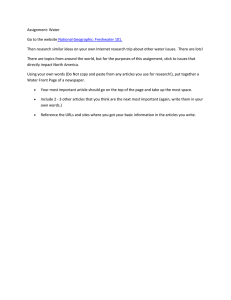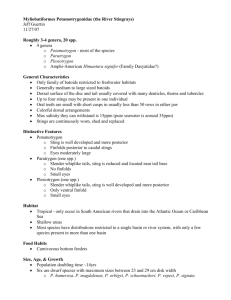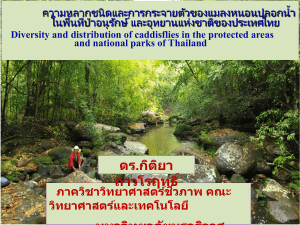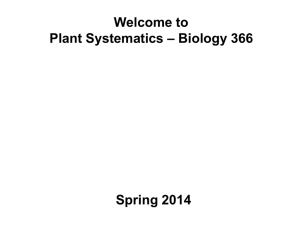Fascinating Species of Wisconsin Wetlands Paul Skawinski Citizen Lake Monitoring Network
advertisement
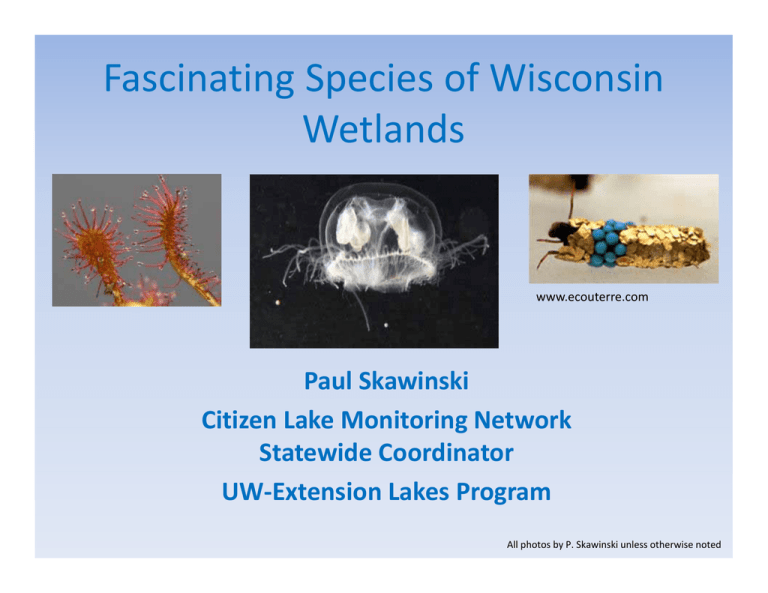
Fascinating Species of Wisconsin Wetlands www.ecouterre.com Paul Skawinski Citizen Lake Monitoring Network Statewide Coordinator UW‐Extension Lakes Program All photos by P. Skawinski unless otherwise noted Purple pitcher plant (Sarracenia purpurea) Grow in a tough environment Leaves formed into pitchers that hold water Stiff, downward‐pointing hairs Bryozoans (Phylum Bryozoa) Colonies of filter‐feeding animals (zooids) Mostly water Pectinatella magnifica – Rocky Run Wetland, Stevens Point Bryozoans (Phylum Bryozoa) Hermaphroditic Up to 12yr life span Right image by: www.photomacrography.net Cristatella mucedo – Roothouse Lake, Lincoln County Bryozoans (Phylum Bryozoa) All zooids are genetically identical Expansion by budding Zooids provide different services to the colony Right image by: www.photomacrography.net Bladderworts (Utricularia spp.) 8 species in Wisconsin Carnivorous Mostly in acid environments Bladderworts (Utricularia spp.) 8 species in Wisconsin Carnivorous Mostly in acid environments Bladderworts (Utricularia spp.) 8 species in Wisconsin Carnivorous Mostly in acid environments Freshwater jellyfish (Craspedacusta sowerbyi) Native to China First seen in WI in 1960s No significant impacts known Caddisflies (Order Trichoptera) Case‐making insects (mostly) Each family has its own type of case Caddisflies (Order Trichoptera) Case‐making insects (mostly) Caddisflies in the Hydropsychidae family are an exception Caddisflies (Order Trichoptera) Employing caddisflies Sundews (Drosera spp.) 4 species known in WI Two strongly prefer acid habitats, two strongly prefer alkaline https://www.youtube.com/watch?v= cZ7Fws1HaL0 Water celery (Vallisneria americana) Primary food source of canvasback duck (Aythya valisineria) Water celery (Vallisneria americana) Transport pollen from the male plant to the female plant without exposing it to water! Water celery (Vallisneria americana) Primary food source of canvasback duck (Aythya valisineria) Water celery (Vallisneria americana) Pollination Female flower Male flower Water celery (Vallisneria americana) Stame Pollination Female flower Male flower Dragonflies (Odonata:Anisoptera) ~120 species known in WI Can fly forward or backward Live for 1‐3 years Dragonflies (Odonata:Anisoptera) ~120 species known in WI Can fly forward or backward Live for 1‐3 years Slow‐motion movie (250 frames/sec) Bog laurel (Kalmia polifolia) https://www.youtube.com/watch?v=iCvrbq3TsFk Giant Water Bug (Lethocerus americanus) ~3.5in max size “Electric light bugs” Eggs laid on emergent vegetation – male guards Giant Water Bug (Lethocerus americanus) Grasp prey with forelegs, injecting a venomous saliva. Painful to humans, but short‐lived. Cattails (Typha spp.) The3foragers.blogspot.com Nearly every part is edible Extremely high productivity Cattails (Typha spp.) Nearly every part is edible Extremely high productivity Typha latifolia vs. Typha angustifolia Fishing Spider (Dolomedes triton) Bugguide.net Common statewide Ballooning Eat fishes, tadpoles, insects Fishing Spider (Dolomedes triton) Bugguide.net Common statewide Ballooning Eat fishes, tadpoles, insects Poison Sumac (Toxicodendron vernix) Up to 20’ tall Compound leaves, gray, scraggly branches Poison Sumac (Toxicodendron vernix) Up to 20’ tall Compound leaves, gray, scraggly branches Poison Sumac (Toxicodendron vernix) Up to 20’ tall Compound leaves, gray, scraggly branches Orange Jewelweed (Impatiens capensis) Swollen stems, orange flowers “Touch‐me‐not” Anti‐itch – very effective on stinging nettle Freshwater sponges (Spongilla spp.) One freshwater family Resemble green fingers or cushions Filter‐feeding animals with symbiotic algae Water quality indicator Freshwater sponges (Spongilla spp.) Most are sessile or nearly so. “Hermit crab sponges” are an exception (not freshwater). Freshwater sponges (Spongilla spp.) Coe College Biology Dept Most are sessile or nearly so. “Hermit crab sponges” are an exception (not freshwater). Wood Frog (Lithobates sylvaticus) Freeze solid during winter Freeze‐thaw cycles are more favorable than straight freezing Whirligig Beetles (Family Gyrinidae) Zig‐zag swim pattern Very smooth and fast Two sets of eyes Whirligig Beetles (Family Gyrinidae) Zig‐zag swim pattern Very smooth and fast Two sets of eyes





